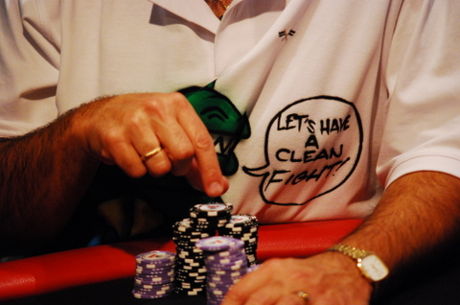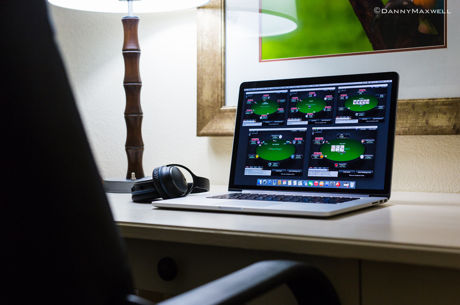The Danger of Projecting Your Own Playing Style Onto Your Opponents

A common lesson in poker strategy �� often picked up early on in a player��s education �� is the one having to do with thinking on different ��levels.��
Players who have learned how to think about not just their own cards, but about what their opponents are holding are said to be thinking on a higher level �� exhibiting first- or second-level thinking (depending on where the counting of levels begins). Above that on the next-highest level are players who can further consider what their opponents think they have. And so on.
For most players, moving up each ��level�� in their poker thinking likely involves making several smaller ��steps�� along the way.
Sure, you start out being generally aware that your opponent��s hand is worth thinking about. But going further and actually learning how to narrow that player��s range involves becoming aware of a lot of other things, too �� things like bet-sizing, pot odds, board texture, the significance of position, and how a player��s apparent style (as demonstrated in earlier hands) might signal something about how the player is playing this particular hand.
There��s one common obstacle, though, that sometimes gets in the way of players moving up and starting to think clearly about an opponents�� hands. It��s an obstacle I would suggest is more difficult for new players to overcome, but can still affect experienced players sometimes, too. The problem can be stated as follows:
When trying to put an opponent on a range of hands, many players instinctively interpret an opponent��s actions in terms of their own style and/or favored strategy.
Thinking ��what would I do here?�� isn��t always such a bad thing to do, actually, especially when you lack other information about a player to help with your reads. But assuming too readily that others play hands the same way you do can be dangerous, causing you to reject erroneously the possibility that other approaches exist.
For example, let��s imagine a hand that begins with Player A limping in from under the gun.
Knowing that limping from early position isn��t generally a recommended play, Player B (sitting in the big blind) almost never does that himself. However, every once in a while he allows himself to limp in from early-to-mid position with small pairs (hoping to flop a set) or suited aces (hoping to flop a flush draw) in an effort to see a flop cheaply.
It folds all of the way around to Player B who looks down at K?7? and checks his option. The flop comes K?J?2?, and Player B check-calls a small bet from Player A. The turn is the 2? and both players check, then the river brings the 9?. Player B checks and watches as Player A makes a big river bet, nearly three-fourths the size of the pot.
Going back through the hand, Player B remembers the UTG limp and translates that action into a narrow range consisting of small pairs and suited aces. He decides the board doesn��t appear to have helped either of those hand types much. The only small pair that improved would be pocket deuces (highly unlikely), and no flush (or ace) has come to help any of those AxXx-suited hands (with only A?2? and A?2? from the latter group having improved).
Having gone through those possibilities, Player B thinks a little further to rule out hands like AxKx or KxQx, meaning he��s talked himself into believing the king in his hand is enough to beat what looks like a big, bluffy bet. He calls, then shakes his head when his opponent shows Q?10? for a king-high straight.
Having projected his own playing style onto an opponent, Player B gave himself big blind spots negatively affecting his ability to consider clearly his opponent��s possible range of hands. While he probably would fold a hand like queen-ten suited from UTG, that doesn��t mean others would do the same.
There are other hands, too, that Player B would never limp with from UTG �� e.g., AxKx, KxQx, KxJx, KxKx, JxJx, 9x9x, Jx9x, Ax2x (unsuited), 2xXx �� with which other players might do so (with varying levels of skill and/or experience).
Like I say, this is a problem that affects newer players more than experienced ones, in part because newer players are often just starting to figure out what ��recommended�� plays are. And once they have learned those plays, the temptation to assume others all know them (and follow them) as well is hard to resist. (This is one reason why you see a lot of ��teaching at the table�� at lower limits online �� players who have learned a little can't help but show in the chatbox what they know.)
Think about it �� who limps in from under the gun with pocket kings? Well, the absolute novice who doesn��t know that you should raise before the flop with premium starting hands might do that. So might the more experienced, savvy player who has noticed his opponents in late position always raising and limps in order to three-bet or perhaps set up a postflop trap.
Meanwhile the player with more knowledge than the novice but less than the savvy player can��t imagine making such a play. Having learned you should raise from all positions with KxKx, that player has a hard time envisioning anyone doing something else with such a hand.
This is not to say you should never interpret an opponent��s actions through the lens of your own playing style. Sometimes it really is helpful to ask ��what would I do here?�� and create a kind of baseline from which to start narrowing a player��s range. Just don��t let your own strategic biases cause you to dismiss possibilities and create those blind spots limiting your ability to see what an opponent could have.
Moving up the levels in your poker thinking is not easy. Don��t make reading others harder than it already is by getting in your own way.
Want to stay atop all the latest in the poker world? If so, make sure to get PokerNews updates on your social media outlets. Follow us on Twitter and find us on both Facebook and Google+!









